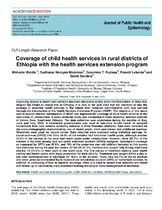Coverage of child health services in rural districts of Ethiopia with the health services extension program

View/
Date
2015Author
Woldie, Mirkuzie
Morankar, Sudhakar Narayan
Feyissa, Garumma T.
Labonte, Ronald
Sanders, David
Metadata
Show full item recordAbstract
Improving access to health care services has been advocated widely since the Declaration of Alma-Ata. Despite the efforts to realize this in Ethiopia, it is only in the year 2003 that the intention to take the package of essential health services to the kebele level (smallest administrative unit) was realized through the introduction of the Health Services Extension Program (HSEP). The objective of this study was to explore whether introduction of HSEP has improved the coverage of child health services in the rural areas of Jimma Zone. A cross sectional study was conducted in three randomly selected districts of Jimma Zone, Southwest Ethiopia. The data collection was undertaken during the months of May, June and July, 2009. A structured questionnaire was used to interview female heads of sampled households from nine kebeles randomly selected in three Woredas (districts). Data were collected on the socio-demographic characteristics, use of health posts, child vaccination and childhood diarrhea. Checklists were used for record review. Data obtained were analysed using statistical package for social sciences (SPSS) V14. Only 64.0% of the kebeles had functional health posts, although another 32.0% of the kebeles in the zone had health posts under construction. However, most (93.7%) of the kebeles in the zone already had two health extension workers (HEWs) assigned. Vaccination coverage as measured by DPT3 was 67.9%, and 10% of the under-two year old children included in this survey had diarrhoea during the past two weeks. Of the 34 (51.5%) mothers who sought help during diarrhoeal attacks, 12 (35.3%) of them went to the health post. The first places of treatment seeking were health centres and health posts, with equal proportion for both (43.5%). Treatment was sought within a day or two after commencement of diarrhoea for 70.6% of the children. Thirty nine (69.7%) of the 56 children who were given recommended fluids received oral rehydration solution (ORS) or homemade solution. In addition to continuing efforts to improve coverage, there is a need to ensure that activities are linked with follow up of vaccination, early treatment seeking and proper home management of diarrhoea.
